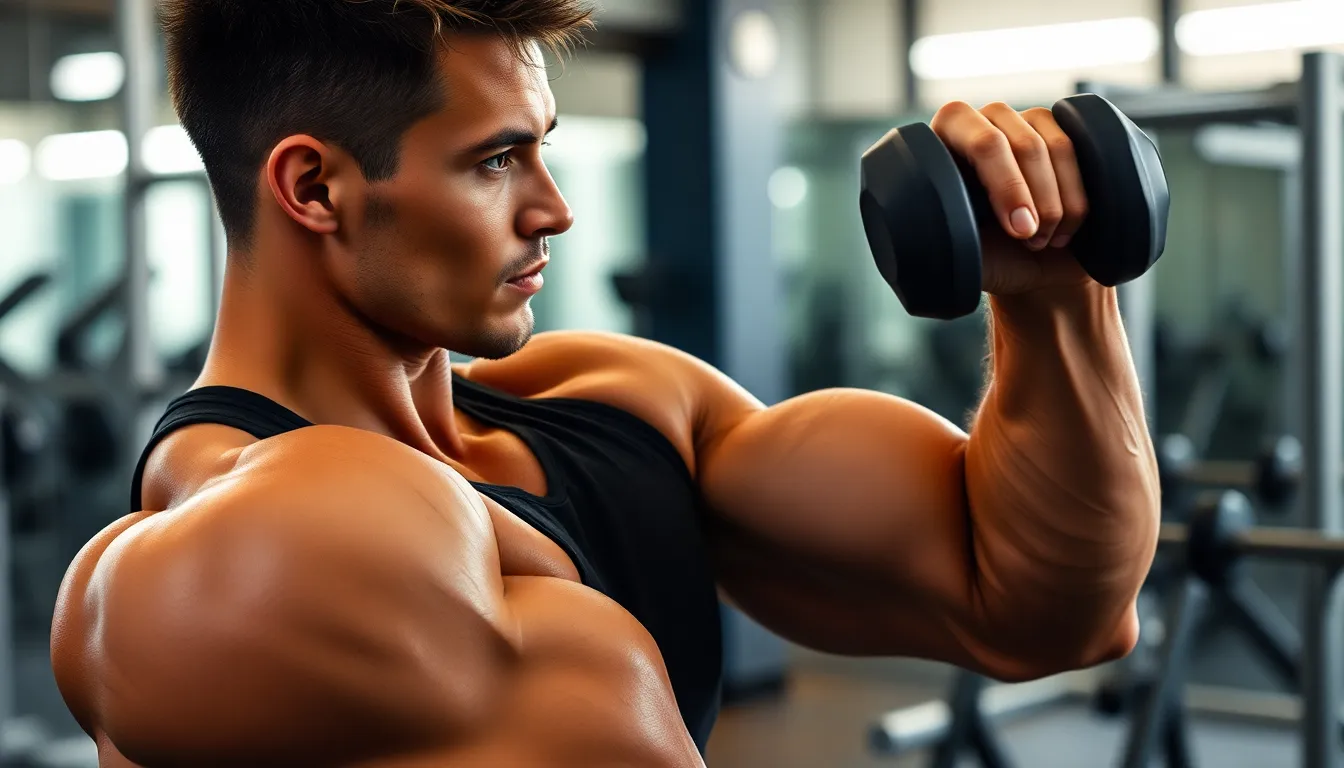Table of Contents
ToggleBuilding strong arms isn’t just about aesthetics; it’s essential for overall strength and functionality. Whether lifting groceries or performing daily tasks, well-defined arms can enhance performance and prevent injuries. With countless exercises available, anyone can tailor their arm workouts to fit their fitness level and goals.
From bicep curls to tricep dips, effective arm workouts engage multiple muscle groups, ensuring balanced development. Incorporating a variety of movements can keep routines fresh and exciting while maximizing results. With the right approach, anyone can achieve toned arms that reflect their hard work and dedication.
Benefits Of Arm Workouts
Arm workouts offer numerous advantages, enhancing both physical performance and appearance. Engaging in regular arm exercises leads to improved strength and enhanced aesthetics.
Improved Strength
Engaging in arm workouts significantly increases muscular strength. Strong arms enable individuals to perform daily tasks, such as lifting and carrying, with ease. Enhanced strength reduces fatigue during physical activities and lowers the risk of injuries. Incorporating resistance exercises, such as bicep curls and tricep dips, effectively develops both the biceps and triceps. This balanced approach to strength training ensures comprehensive muscle growth and functional strength.
Enhanced Aesthetics
Arm workouts contribute to a toned and defined appearance. Strengthening arm muscles leads to a sculpted look that reflects physical fitness. Engaging in various exercises, including overhead presses and lateral raises, promotes definition across multiple muscle groups. Aesthetic improvements can boost confidence and encourage further commitment to fitness goals. Regular training fosters visible results, making it easier to achieve a balanced and attractive physique.
Types Of Arm Workouts

Arm workouts include various types of exercises that target specific muscle groups within the arms. The main categories consist of weightlifting exercises and bodyweight exercises.
Weightlifting Exercises
Weightlifting exercises effectively build muscle mass and strength in the arms. They focus on resistance training to promote hypertrophy and endurance. Key weightlifting exercises include:
- Bicep Curls: Target the biceps brachii and improve arm size and definition.
- Tricep Extensions: Strengthen the triceps, enhancing the back of the arms for balanced development.
- Dumbbell Flyes: Engage the shoulder muscles while providing some activation in the arms, contributing to overall stability.
- Hammer Curls: Work the brachialis and brachioradialis, adding thickness to the arms.
- Skull Crushers: Focus on the triceps, effectively isolating and developing this key muscle group.
Incorporating these exercises into a routine maximizes gains and promotes arm strength.
Bodyweight Exercises
Bodyweight exercises utilize an individual’s weight as resistance, offering an accessible and versatile option for arm training. Key bodyweight exercises include:
- Push-ups: Enhance overall upper body strength while engaging the arms, chest, and shoulders.
- Dips: Utilize parallel bars or benches to strengthen the triceps, shoulders, and chest.
- Plank Ups: Transition between plank positions to target the shoulders and arms dynamically.
- Chin-ups: Focus on the biceps and upper back, demanding control and strength.
- Diamond Push-ups: Alter standard push-ups to intensify tricep engagement and promote definition.
These exercises suit various fitness levels and can be modified to increase or decrease difficulty.
Essential Techniques For Arm Workouts
Focusing on essential techniques enhances the effectiveness of arm workouts. Proper form and progressive overload play significant roles in achieving optimal results.
Proper Form
Maintaining proper form ensures maximum engagement of arm muscles and minimizes injury risk. Key aspects of proper form include:
- Alignment: Keep the arms aligned with the body during exercises to stabilize movement.
- Grip: Use an appropriate grip for each exercise; for instance, a supinated grip for bicep curls maximizes tension in the biceps.
- Controlled Movement: Perform exercises in a controlled manner to emphasize muscle engagement. Avoid swinging or using momentum.
- Breathing: Exhale during the exertion phase and inhale during the relaxation phase. This aids in maintaining proper form and keeps oxygen flowing.
Progressive Overload
Progressive overload involves gradually increasing the resistance or intensity of exercises to promote muscle growth. Effective methods for implementing progressive overload include:
- Weight Increments: Increase weights by 5-10% once current weights feel manageable. This threshold ensures continued muscle challenge.
- Repetition Variations: Add 1-2 more repetitions per set to stimulate muscle fibers further.
- Time Under Tension: Slow down the eccentric phase (lowering) of the lift. This increases time under tension, enhancing strength gains.
- Exercise Modifications: Incorporate advanced variations of exercises, such as adding a pause at the peak of a bicep curl or using single-arm movements for added challenge.
Implementing these essential techniques builds stronger arms while enhancing workout effectiveness and safety.
Common Mistakes In Arm Workouts
Common mistakes can hinder progress and increase injury risk during arm workouts. Avoiding these mistakes ensures effective training and balanced muscle development.
Overtraining
Overtraining can lead to fatigue and decreased performance. Training arms excessively without adequate rest results in diminished returns and potential injuries. Signs of overtraining include persistent soreness, decreased strength, and disrupted sleep. To combat this, incorporate rest days into the routine and prioritize recovery methods, such as stretching and hydration. Allowing 48 hours between arm workouts promotes optimal muscle recovery.
Neglecting Other Muscle Groups
Neglecting other muscle groups can create imbalances, impacting overall strength and aesthetics. Focusing solely on arm workouts may lead to underdeveloped chest, back, and shoulder muscles. Balanced training fosters symmetry and functionality, reducing injury risks associated with muscle imbalances. Incorporate compound movements like push-ups and rows to engage multiple muscle groups, ensuring a well-rounded fitness approach and enhancing overall arm performance.
Building strong arms is essential for enhancing overall strength and functionality. By incorporating a mix of weightlifting and bodyweight exercises into a routine, individuals can achieve balanced development and prevent injury. Emphasizing proper form and progressive overload ensures workouts remain effective and safe.
Staying committed to arm workouts not only boosts physical performance but also contributes to a sculpted appearance that can elevate confidence. With dedication and the right techniques, anyone can transform their arm strength and enjoy the benefits that come with it.




